ASEAN Free Trade Area Analysis
VerifiedAdded on 2020/05/16
|14
|2571
|38
AI Summary
This assignment delves into the ASEAN Free Trade Area (AFTA), examining its structure, evolution, and implications for member nations. It explores various aspects such as trade facilitation, investment flows, economic growth, and the impact on different sectors within ASEAN countries. The provided resources offer insights into AFTA's benefits for citizens, challenges faced, and future prospects.
Contribute Materials
Your contribution can guide someone’s learning journey. Share your
documents today.
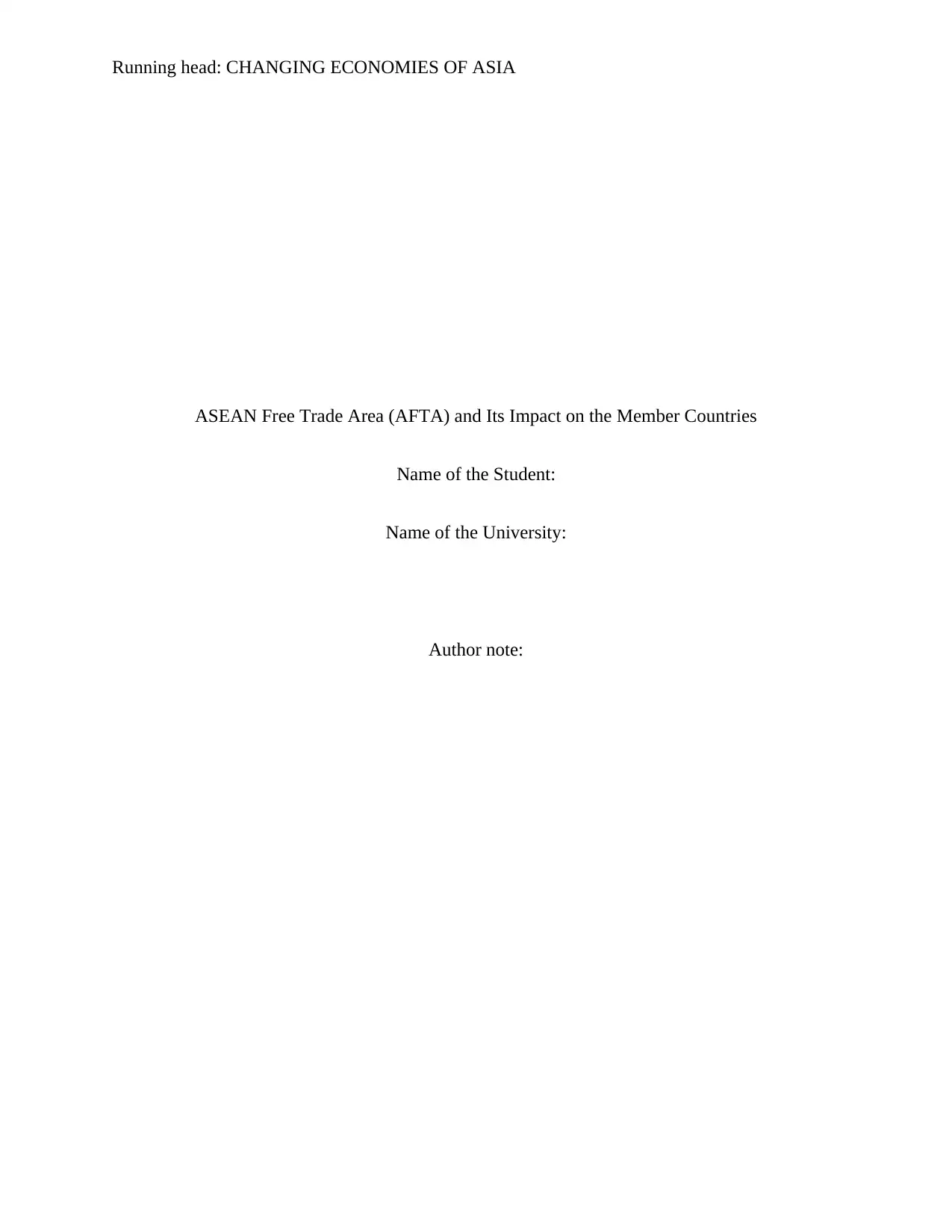
Running head: CHANGING ECONOMIES OF ASIA
ASEAN Free Trade Area (AFTA) and Its Impact on the Member Countries
Name of the Student:
Name of the University:
Author note:
ASEAN Free Trade Area (AFTA) and Its Impact on the Member Countries
Name of the Student:
Name of the University:
Author note:
Secure Best Marks with AI Grader
Need help grading? Try our AI Grader for instant feedback on your assignments.

1CHANGING ECONOMIES OF ASIA
Introduction
The developing countries of Asia have experienced development over the past few
decades, especially after the era of global trade liberalization, due to the existence of various
regional trade agreements (RTAs) among the countries. There are many RTAs in Asia that cover
the developing countries in many ways, with the major objective of promoting the overall
economic development of the signatory countries. World’s half production and consumption
market is presented by the Asian countries and the RTAs play a vital role in determining the
economic stability and growth of that region1. The regional trade agreements have benefitted the
signatory countries in economic growth and development, economic and political relations,
trade, investment, services, industry and social welfare.
ASEAN Free Trade Area (AFTA) is a regional trade agreement by the Association of
Southeast Asian Nations (ASEAN), established to support the local manufacturing industry in all
the ASEAN countries. The agreement was signed in Singapore in January 19922. During the
establishment, there were only six members in this agreement, namely, Indonesia, Singapore,
Thailand, Philippines, Malaysia and Brunei. Vietnam, Laos, Myanmar and Cambodia joined the
agreement in 1995, 1997 and 1999 respectively. Thus, currently, the agreement covers the above
mentioned 10 countries and has contributed immensely in the growth of those countries. It
created a regional market for almost 500 million people3. The features and impact of the AFTA
on the signatory countries is the thesis of this following essay.
Discussion
1 Kawai, Masahiro, and Ganeshan Wignaraja. 2013. "Patterns of free trade areas in Asia."
2 Aggarwal, Vinod, and Shujiro Urata, eds. 2013. Bilateral trade agreements in the Asia-Pacific: Origins, evolution,
and implications. Routledge.
3 DeRosa, Dean A. 2012. "The ASEAN free trade area plan and intra-regional trade in developing Asia."
Introduction
The developing countries of Asia have experienced development over the past few
decades, especially after the era of global trade liberalization, due to the existence of various
regional trade agreements (RTAs) among the countries. There are many RTAs in Asia that cover
the developing countries in many ways, with the major objective of promoting the overall
economic development of the signatory countries. World’s half production and consumption
market is presented by the Asian countries and the RTAs play a vital role in determining the
economic stability and growth of that region1. The regional trade agreements have benefitted the
signatory countries in economic growth and development, economic and political relations,
trade, investment, services, industry and social welfare.
ASEAN Free Trade Area (AFTA) is a regional trade agreement by the Association of
Southeast Asian Nations (ASEAN), established to support the local manufacturing industry in all
the ASEAN countries. The agreement was signed in Singapore in January 19922. During the
establishment, there were only six members in this agreement, namely, Indonesia, Singapore,
Thailand, Philippines, Malaysia and Brunei. Vietnam, Laos, Myanmar and Cambodia joined the
agreement in 1995, 1997 and 1999 respectively. Thus, currently, the agreement covers the above
mentioned 10 countries and has contributed immensely in the growth of those countries. It
created a regional market for almost 500 million people3. The features and impact of the AFTA
on the signatory countries is the thesis of this following essay.
Discussion
1 Kawai, Masahiro, and Ganeshan Wignaraja. 2013. "Patterns of free trade areas in Asia."
2 Aggarwal, Vinod, and Shujiro Urata, eds. 2013. Bilateral trade agreements in the Asia-Pacific: Origins, evolution,
and implications. Routledge.
3 DeRosa, Dean A. 2012. "The ASEAN free trade area plan and intra-regional trade in developing Asia."
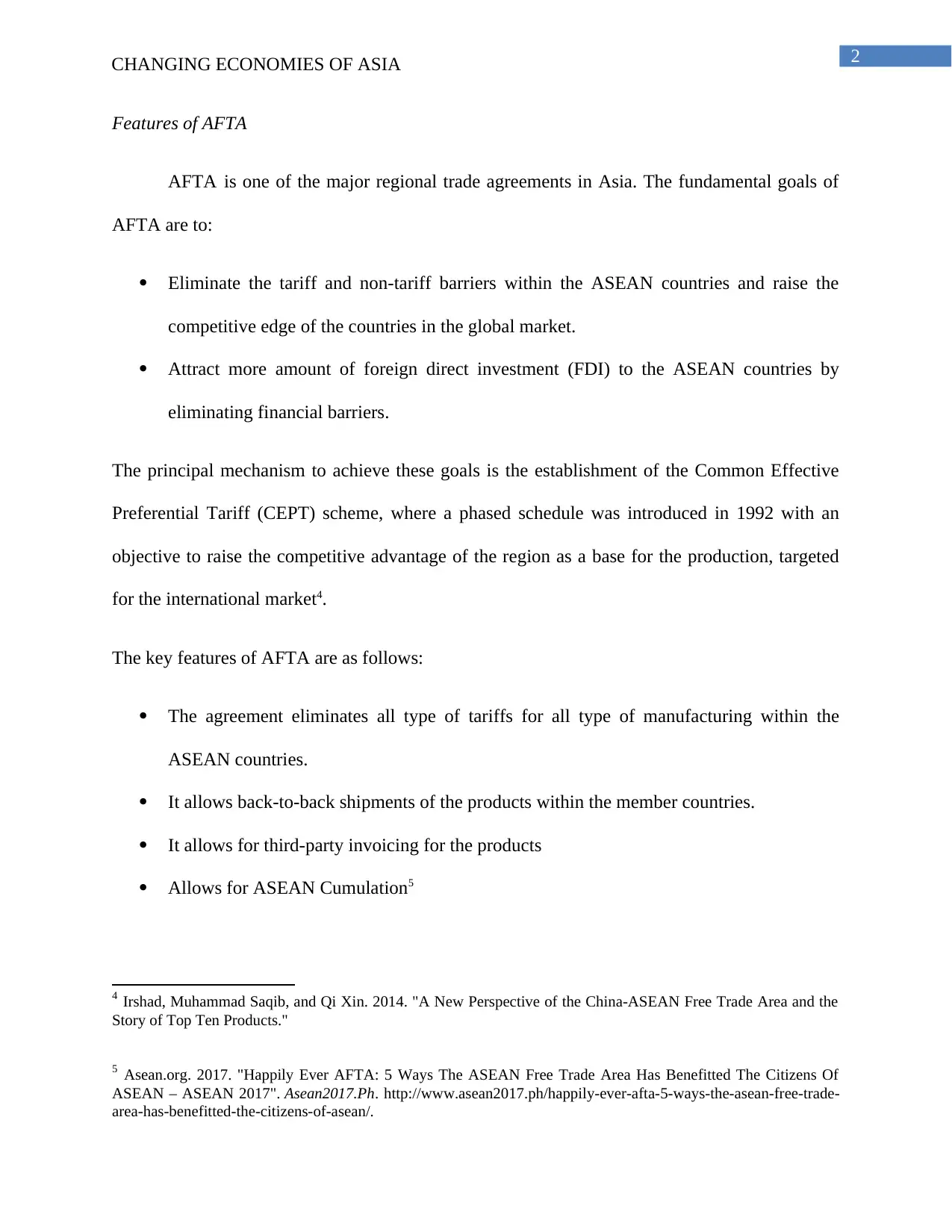
2CHANGING ECONOMIES OF ASIA
Features of AFTA
AFTA is one of the major regional trade agreements in Asia. The fundamental goals of
AFTA are to:
Eliminate the tariff and non-tariff barriers within the ASEAN countries and raise the
competitive edge of the countries in the global market.
Attract more amount of foreign direct investment (FDI) to the ASEAN countries by
eliminating financial barriers.
The principal mechanism to achieve these goals is the establishment of the Common Effective
Preferential Tariff (CEPT) scheme, where a phased schedule was introduced in 1992 with an
objective to raise the competitive advantage of the region as a base for the production, targeted
for the international market4.
The key features of AFTA are as follows:
The agreement eliminates all type of tariffs for all type of manufacturing within the
ASEAN countries.
It allows back-to-back shipments of the products within the member countries.
It allows for third-party invoicing for the products
Allows for ASEAN Cumulation5
4 Irshad, Muhammad Saqib, and Qi Xin. 2014. "A New Perspective of the China-ASEAN Free Trade Area and the
Story of Top Ten Products."
5 Asean.org. 2017. "Happily Ever AFTA: 5 Ways The ASEAN Free Trade Area Has Benefitted The Citizens Of
ASEAN – ASEAN 2017". Asean2017.Ph. http://www.asean2017.ph/happily-ever-afta-5-ways-the-asean-free-trade-
area-has-benefitted-the-citizens-of-asean/.
Features of AFTA
AFTA is one of the major regional trade agreements in Asia. The fundamental goals of
AFTA are to:
Eliminate the tariff and non-tariff barriers within the ASEAN countries and raise the
competitive edge of the countries in the global market.
Attract more amount of foreign direct investment (FDI) to the ASEAN countries by
eliminating financial barriers.
The principal mechanism to achieve these goals is the establishment of the Common Effective
Preferential Tariff (CEPT) scheme, where a phased schedule was introduced in 1992 with an
objective to raise the competitive advantage of the region as a base for the production, targeted
for the international market4.
The key features of AFTA are as follows:
The agreement eliminates all type of tariffs for all type of manufacturing within the
ASEAN countries.
It allows back-to-back shipments of the products within the member countries.
It allows for third-party invoicing for the products
Allows for ASEAN Cumulation5
4 Irshad, Muhammad Saqib, and Qi Xin. 2014. "A New Perspective of the China-ASEAN Free Trade Area and the
Story of Top Ten Products."
5 Asean.org. 2017. "Happily Ever AFTA: 5 Ways The ASEAN Free Trade Area Has Benefitted The Citizens Of
ASEAN – ASEAN 2017". Asean2017.Ph. http://www.asean2017.ph/happily-ever-afta-5-ways-the-asean-free-trade-
area-has-benefitted-the-citizens-of-asean/.
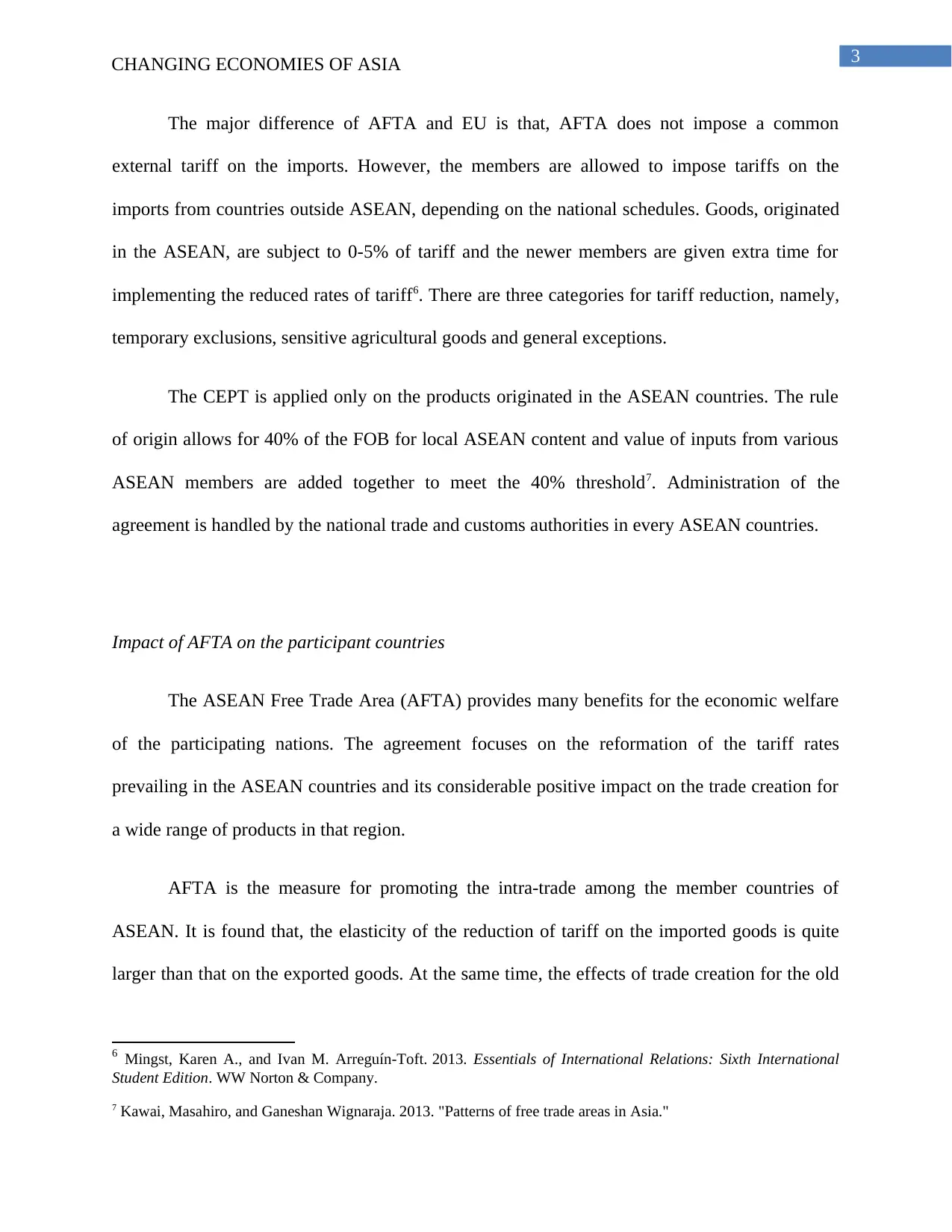
3CHANGING ECONOMIES OF ASIA
The major difference of AFTA and EU is that, AFTA does not impose a common
external tariff on the imports. However, the members are allowed to impose tariffs on the
imports from countries outside ASEAN, depending on the national schedules. Goods, originated
in the ASEAN, are subject to 0-5% of tariff and the newer members are given extra time for
implementing the reduced rates of tariff6. There are three categories for tariff reduction, namely,
temporary exclusions, sensitive agricultural goods and general exceptions.
The CEPT is applied only on the products originated in the ASEAN countries. The rule
of origin allows for 40% of the FOB for local ASEAN content and value of inputs from various
ASEAN members are added together to meet the 40% threshold7. Administration of the
agreement is handled by the national trade and customs authorities in every ASEAN countries.
Impact of AFTA on the participant countries
The ASEAN Free Trade Area (AFTA) provides many benefits for the economic welfare
of the participating nations. The agreement focuses on the reformation of the tariff rates
prevailing in the ASEAN countries and its considerable positive impact on the trade creation for
a wide range of products in that region.
AFTA is the measure for promoting the intra-trade among the member countries of
ASEAN. It is found that, the elasticity of the reduction of tariff on the imported goods is quite
larger than that on the exported goods. At the same time, the effects of trade creation for the old
6 Mingst, Karen A., and Ivan M. Arreguín-Toft. 2013. Essentials of International Relations: Sixth International
Student Edition. WW Norton & Company.
7 Kawai, Masahiro, and Ganeshan Wignaraja. 2013. "Patterns of free trade areas in Asia."
The major difference of AFTA and EU is that, AFTA does not impose a common
external tariff on the imports. However, the members are allowed to impose tariffs on the
imports from countries outside ASEAN, depending on the national schedules. Goods, originated
in the ASEAN, are subject to 0-5% of tariff and the newer members are given extra time for
implementing the reduced rates of tariff6. There are three categories for tariff reduction, namely,
temporary exclusions, sensitive agricultural goods and general exceptions.
The CEPT is applied only on the products originated in the ASEAN countries. The rule
of origin allows for 40% of the FOB for local ASEAN content and value of inputs from various
ASEAN members are added together to meet the 40% threshold7. Administration of the
agreement is handled by the national trade and customs authorities in every ASEAN countries.
Impact of AFTA on the participant countries
The ASEAN Free Trade Area (AFTA) provides many benefits for the economic welfare
of the participating nations. The agreement focuses on the reformation of the tariff rates
prevailing in the ASEAN countries and its considerable positive impact on the trade creation for
a wide range of products in that region.
AFTA is the measure for promoting the intra-trade among the member countries of
ASEAN. It is found that, the elasticity of the reduction of tariff on the imported goods is quite
larger than that on the exported goods. At the same time, the effects of trade creation for the old
6 Mingst, Karen A., and Ivan M. Arreguín-Toft. 2013. Essentials of International Relations: Sixth International
Student Edition. WW Norton & Company.
7 Kawai, Masahiro, and Ganeshan Wignaraja. 2013. "Patterns of free trade areas in Asia."
Secure Best Marks with AI Grader
Need help grading? Try our AI Grader for instant feedback on your assignments.
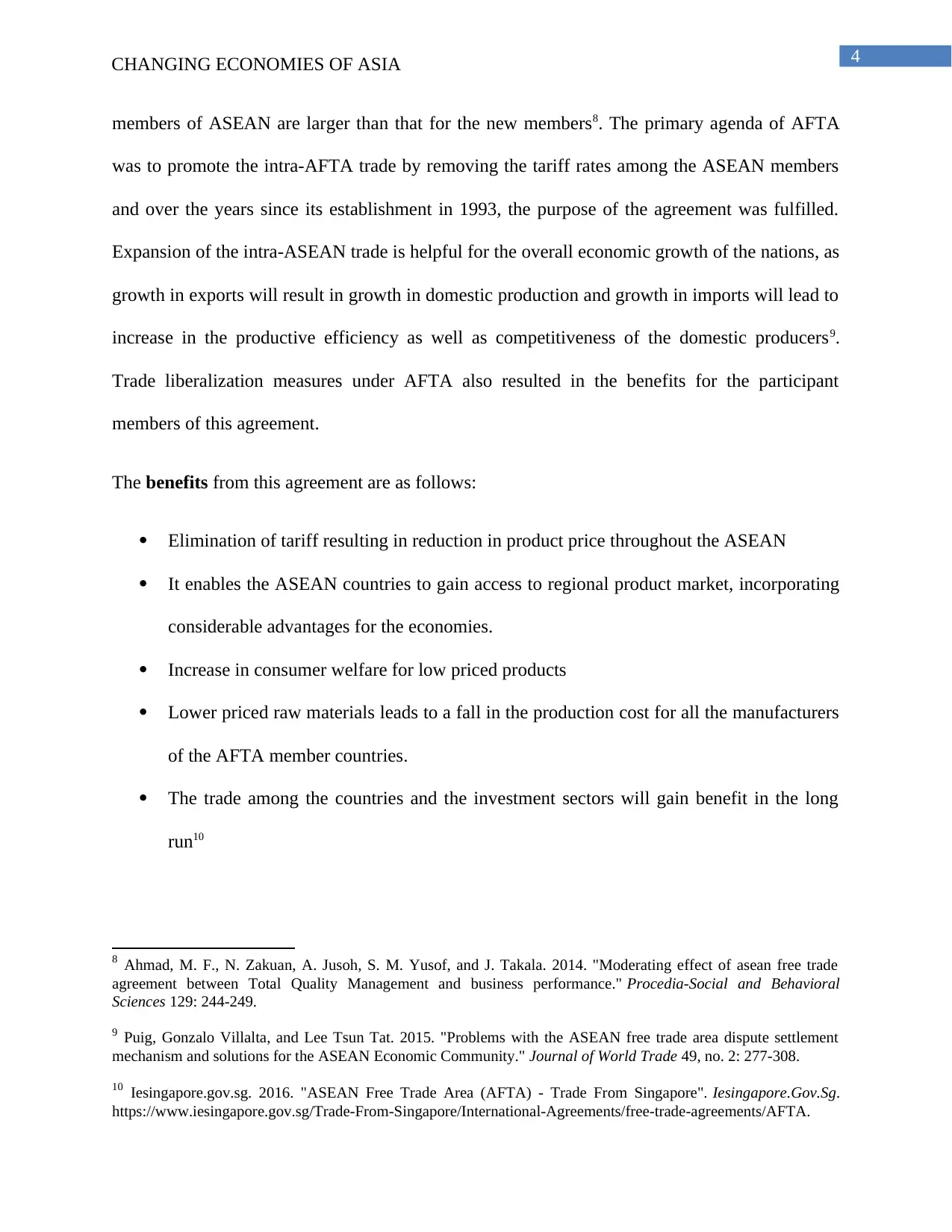
4CHANGING ECONOMIES OF ASIA
members of ASEAN are larger than that for the new members8. The primary agenda of AFTA
was to promote the intra-AFTA trade by removing the tariff rates among the ASEAN members
and over the years since its establishment in 1993, the purpose of the agreement was fulfilled.
Expansion of the intra-ASEAN trade is helpful for the overall economic growth of the nations, as
growth in exports will result in growth in domestic production and growth in imports will lead to
increase in the productive efficiency as well as competitiveness of the domestic producers9.
Trade liberalization measures under AFTA also resulted in the benefits for the participant
members of this agreement.
The benefits from this agreement are as follows:
Elimination of tariff resulting in reduction in product price throughout the ASEAN
It enables the ASEAN countries to gain access to regional product market, incorporating
considerable advantages for the economies.
Increase in consumer welfare for low priced products
Lower priced raw materials leads to a fall in the production cost for all the manufacturers
of the AFTA member countries.
The trade among the countries and the investment sectors will gain benefit in the long
run10
8 Ahmad, M. F., N. Zakuan, A. Jusoh, S. M. Yusof, and J. Takala. 2014. "Moderating effect of asean free trade
agreement between Total Quality Management and business performance." Procedia-Social and Behavioral
Sciences 129: 244-249.
9 Puig, Gonzalo Villalta, and Lee Tsun Tat. 2015. "Problems with the ASEAN free trade area dispute settlement
mechanism and solutions for the ASEAN Economic Community." Journal of World Trade 49, no. 2: 277-308.
10 Iesingapore.gov.sg. 2016. "ASEAN Free Trade Area (AFTA) - Trade From Singapore". Iesingapore.Gov.Sg.
https://www.iesingapore.gov.sg/Trade-From-Singapore/International-Agreements/free-trade-agreements/AFTA.
members of ASEAN are larger than that for the new members8. The primary agenda of AFTA
was to promote the intra-AFTA trade by removing the tariff rates among the ASEAN members
and over the years since its establishment in 1993, the purpose of the agreement was fulfilled.
Expansion of the intra-ASEAN trade is helpful for the overall economic growth of the nations, as
growth in exports will result in growth in domestic production and growth in imports will lead to
increase in the productive efficiency as well as competitiveness of the domestic producers9.
Trade liberalization measures under AFTA also resulted in the benefits for the participant
members of this agreement.
The benefits from this agreement are as follows:
Elimination of tariff resulting in reduction in product price throughout the ASEAN
It enables the ASEAN countries to gain access to regional product market, incorporating
considerable advantages for the economies.
Increase in consumer welfare for low priced products
Lower priced raw materials leads to a fall in the production cost for all the manufacturers
of the AFTA member countries.
The trade among the countries and the investment sectors will gain benefit in the long
run10
8 Ahmad, M. F., N. Zakuan, A. Jusoh, S. M. Yusof, and J. Takala. 2014. "Moderating effect of asean free trade
agreement between Total Quality Management and business performance." Procedia-Social and Behavioral
Sciences 129: 244-249.
9 Puig, Gonzalo Villalta, and Lee Tsun Tat. 2015. "Problems with the ASEAN free trade area dispute settlement
mechanism and solutions for the ASEAN Economic Community." Journal of World Trade 49, no. 2: 277-308.
10 Iesingapore.gov.sg. 2016. "ASEAN Free Trade Area (AFTA) - Trade From Singapore". Iesingapore.Gov.Sg.
https://www.iesingapore.gov.sg/Trade-From-Singapore/International-Agreements/free-trade-agreements/AFTA.
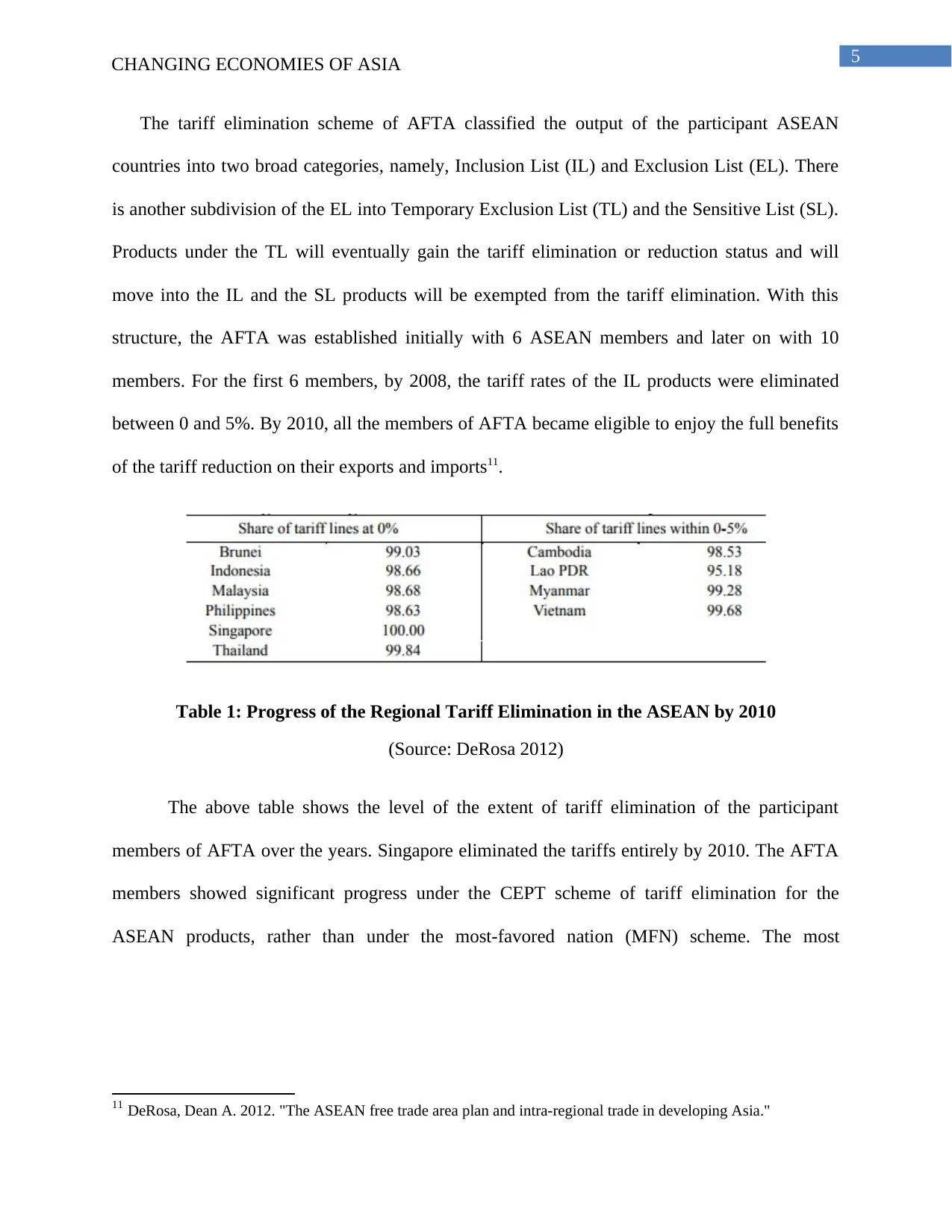
5CHANGING ECONOMIES OF ASIA
The tariff elimination scheme of AFTA classified the output of the participant ASEAN
countries into two broad categories, namely, Inclusion List (IL) and Exclusion List (EL). There
is another subdivision of the EL into Temporary Exclusion List (TL) and the Sensitive List (SL).
Products under the TL will eventually gain the tariff elimination or reduction status and will
move into the IL and the SL products will be exempted from the tariff elimination. With this
structure, the AFTA was established initially with 6 ASEAN members and later on with 10
members. For the first 6 members, by 2008, the tariff rates of the IL products were eliminated
between 0 and 5%. By 2010, all the members of AFTA became eligible to enjoy the full benefits
of the tariff reduction on their exports and imports11.
Table 1: Progress of the Regional Tariff Elimination in the ASEAN by 2010
(Source: DeRosa 2012)
The above table shows the level of the extent of tariff elimination of the participant
members of AFTA over the years. Singapore eliminated the tariffs entirely by 2010. The AFTA
members showed significant progress under the CEPT scheme of tariff elimination for the
ASEAN products, rather than under the most-favored nation (MFN) scheme. The most
11 DeRosa, Dean A. 2012. "The ASEAN free trade area plan and intra-regional trade in developing Asia."
The tariff elimination scheme of AFTA classified the output of the participant ASEAN
countries into two broad categories, namely, Inclusion List (IL) and Exclusion List (EL). There
is another subdivision of the EL into Temporary Exclusion List (TL) and the Sensitive List (SL).
Products under the TL will eventually gain the tariff elimination or reduction status and will
move into the IL and the SL products will be exempted from the tariff elimination. With this
structure, the AFTA was established initially with 6 ASEAN members and later on with 10
members. For the first 6 members, by 2008, the tariff rates of the IL products were eliminated
between 0 and 5%. By 2010, all the members of AFTA became eligible to enjoy the full benefits
of the tariff reduction on their exports and imports11.
Table 1: Progress of the Regional Tariff Elimination in the ASEAN by 2010
(Source: DeRosa 2012)
The above table shows the level of the extent of tariff elimination of the participant
members of AFTA over the years. Singapore eliminated the tariffs entirely by 2010. The AFTA
members showed significant progress under the CEPT scheme of tariff elimination for the
ASEAN products, rather than under the most-favored nation (MFN) scheme. The most
11 DeRosa, Dean A. 2012. "The ASEAN free trade area plan and intra-regional trade in developing Asia."
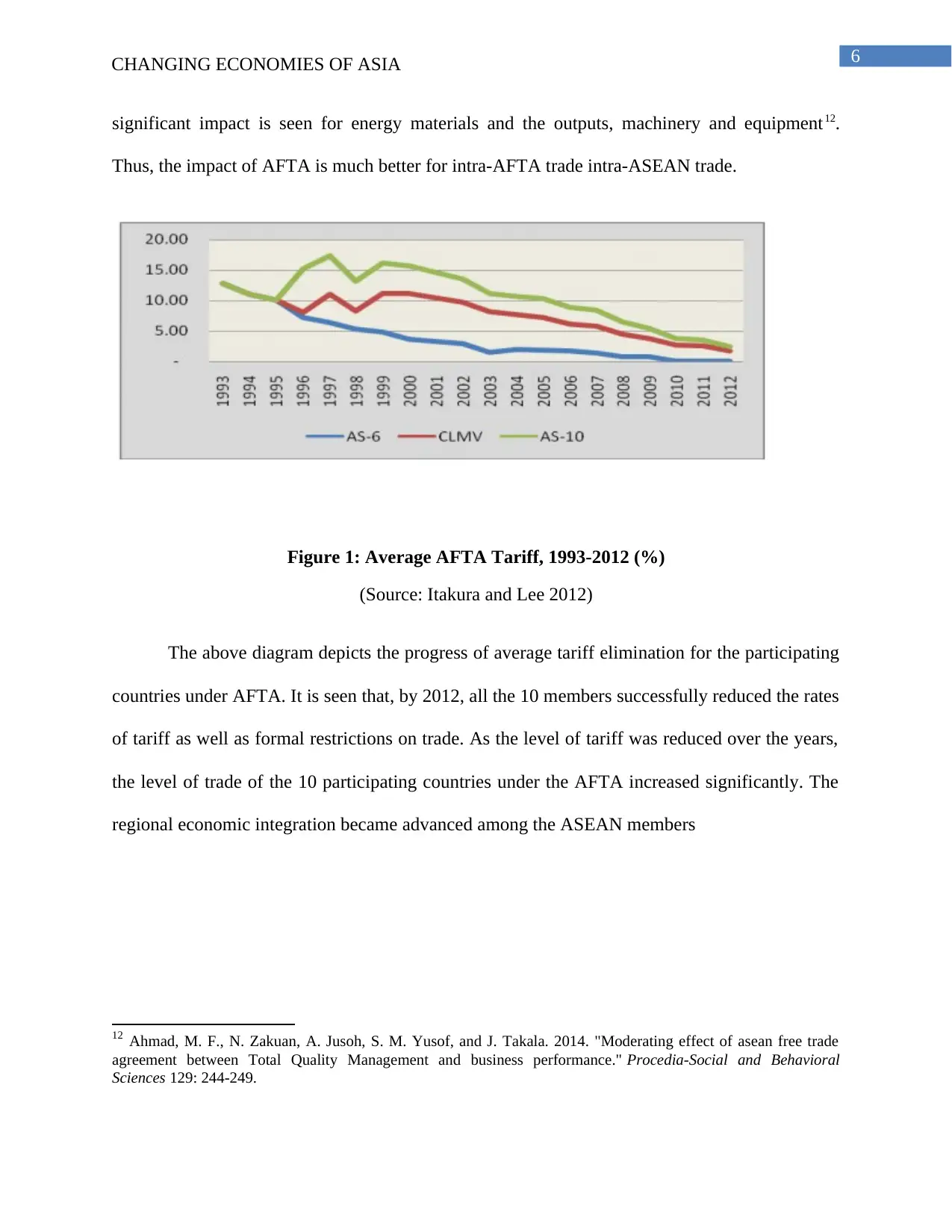
6CHANGING ECONOMIES OF ASIA
significant impact is seen for energy materials and the outputs, machinery and equipment12.
Thus, the impact of AFTA is much better for intra-AFTA trade intra-ASEAN trade.
Figure 1: Average AFTA Tariff, 1993-2012 (%)
(Source: Itakura and Lee 2012)
The above diagram depicts the progress of average tariff elimination for the participating
countries under AFTA. It is seen that, by 2012, all the 10 members successfully reduced the rates
of tariff as well as formal restrictions on trade. As the level of tariff was reduced over the years,
the level of trade of the 10 participating countries under the AFTA increased significantly. The
regional economic integration became advanced among the ASEAN members
12 Ahmad, M. F., N. Zakuan, A. Jusoh, S. M. Yusof, and J. Takala. 2014. "Moderating effect of asean free trade
agreement between Total Quality Management and business performance." Procedia-Social and Behavioral
Sciences 129: 244-249.
significant impact is seen for energy materials and the outputs, machinery and equipment12.
Thus, the impact of AFTA is much better for intra-AFTA trade intra-ASEAN trade.
Figure 1: Average AFTA Tariff, 1993-2012 (%)
(Source: Itakura and Lee 2012)
The above diagram depicts the progress of average tariff elimination for the participating
countries under AFTA. It is seen that, by 2012, all the 10 members successfully reduced the rates
of tariff as well as formal restrictions on trade. As the level of tariff was reduced over the years,
the level of trade of the 10 participating countries under the AFTA increased significantly. The
regional economic integration became advanced among the ASEAN members
12 Ahmad, M. F., N. Zakuan, A. Jusoh, S. M. Yusof, and J. Takala. 2014. "Moderating effect of asean free trade
agreement between Total Quality Management and business performance." Procedia-Social and Behavioral
Sciences 129: 244-249.
Paraphrase This Document
Need a fresh take? Get an instant paraphrase of this document with our AI Paraphraser
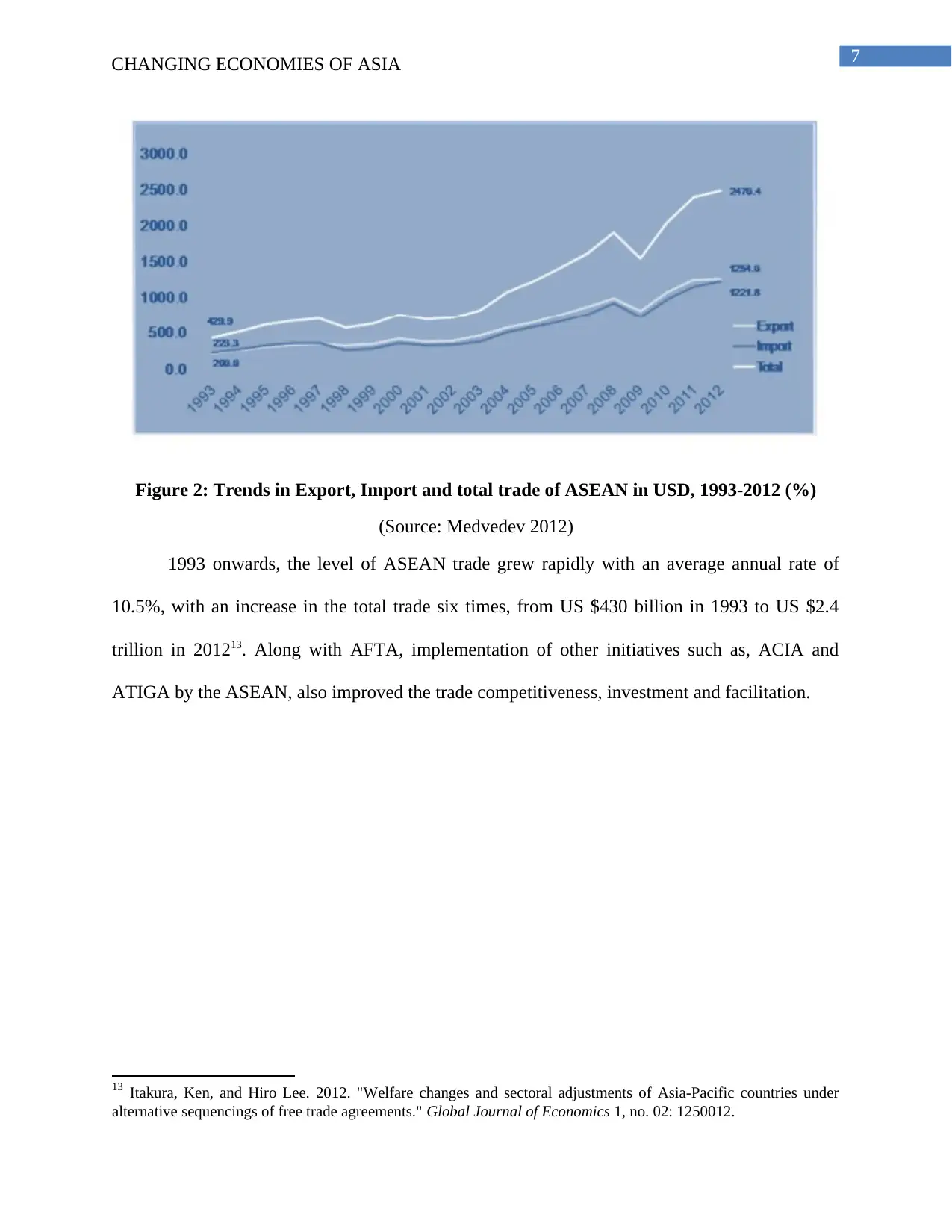
7CHANGING ECONOMIES OF ASIA
Figure 2: Trends in Export, Import and total trade of ASEAN in USD, 1993-2012 (%)
(Source: Medvedev 2012)
1993 onwards, the level of ASEAN trade grew rapidly with an average annual rate of
10.5%, with an increase in the total trade six times, from US $430 billion in 1993 to US $2.4
trillion in 201213. Along with AFTA, implementation of other initiatives such as, ACIA and
ATIGA by the ASEAN, also improved the trade competitiveness, investment and facilitation.
13 Itakura, Ken, and Hiro Lee. 2012. "Welfare changes and sectoral adjustments of Asia-Pacific countries under
alternative sequencings of free trade agreements." Global Journal of Economics 1, no. 02: 1250012.
Figure 2: Trends in Export, Import and total trade of ASEAN in USD, 1993-2012 (%)
(Source: Medvedev 2012)
1993 onwards, the level of ASEAN trade grew rapidly with an average annual rate of
10.5%, with an increase in the total trade six times, from US $430 billion in 1993 to US $2.4
trillion in 201213. Along with AFTA, implementation of other initiatives such as, ACIA and
ATIGA by the ASEAN, also improved the trade competitiveness, investment and facilitation.
13 Itakura, Ken, and Hiro Lee. 2012. "Welfare changes and sectoral adjustments of Asia-Pacific countries under
alternative sequencings of free trade agreements." Global Journal of Economics 1, no. 02: 1250012.
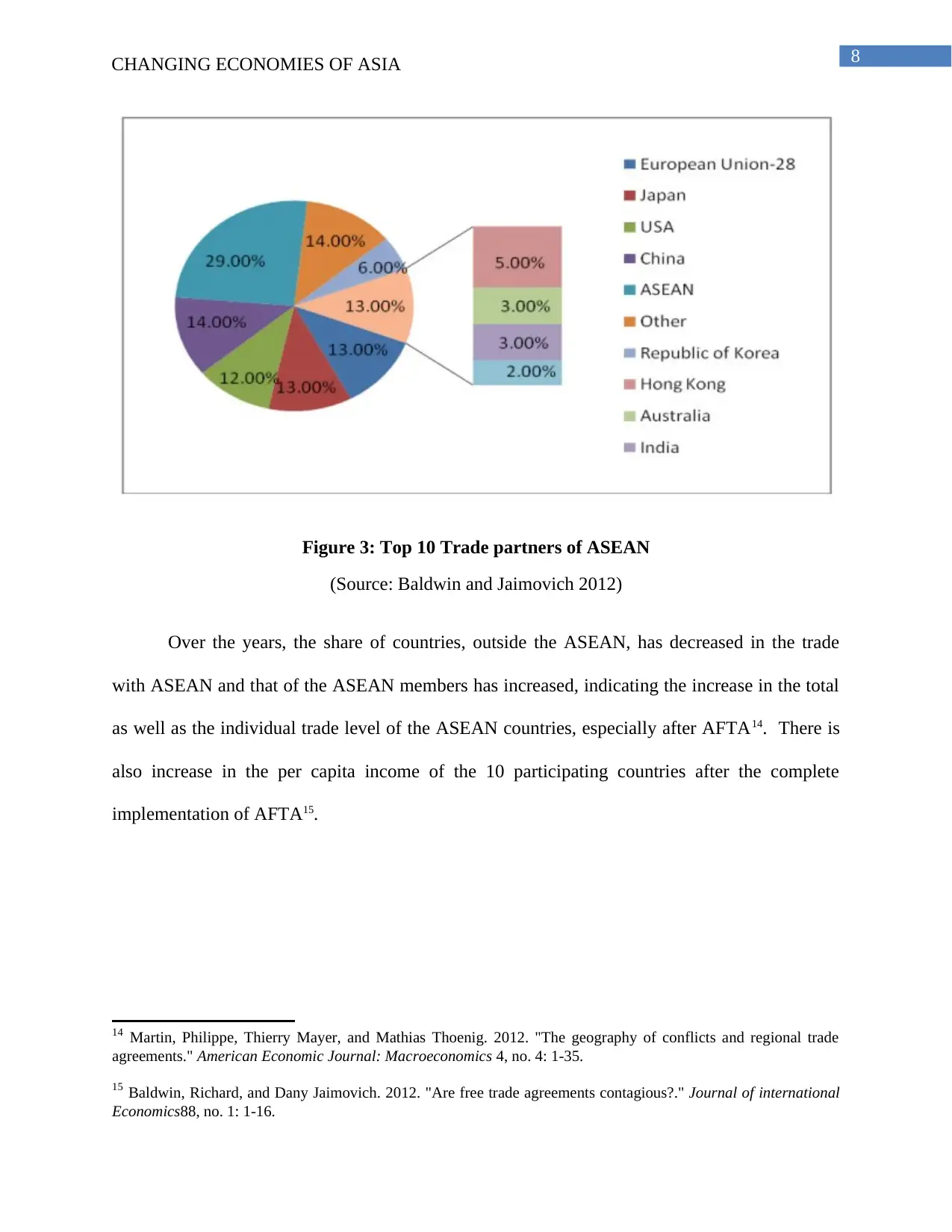
8CHANGING ECONOMIES OF ASIA
Figure 3: Top 10 Trade partners of ASEAN
(Source: Baldwin and Jaimovich 2012)
Over the years, the share of countries, outside the ASEAN, has decreased in the trade
with ASEAN and that of the ASEAN members has increased, indicating the increase in the total
as well as the individual trade level of the ASEAN countries, especially after AFTA14. There is
also increase in the per capita income of the 10 participating countries after the complete
implementation of AFTA15.
14 Martin, Philippe, Thierry Mayer, and Mathias Thoenig. 2012. "The geography of conflicts and regional trade
agreements." American Economic Journal: Macroeconomics 4, no. 4: 1-35.
15 Baldwin, Richard, and Dany Jaimovich. 2012. "Are free trade agreements contagious?." Journal of international
Economics88, no. 1: 1-16.
Figure 3: Top 10 Trade partners of ASEAN
(Source: Baldwin and Jaimovich 2012)
Over the years, the share of countries, outside the ASEAN, has decreased in the trade
with ASEAN and that of the ASEAN members has increased, indicating the increase in the total
as well as the individual trade level of the ASEAN countries, especially after AFTA14. There is
also increase in the per capita income of the 10 participating countries after the complete
implementation of AFTA15.
14 Martin, Philippe, Thierry Mayer, and Mathias Thoenig. 2012. "The geography of conflicts and regional trade
agreements." American Economic Journal: Macroeconomics 4, no. 4: 1-35.
15 Baldwin, Richard, and Dany Jaimovich. 2012. "Are free trade agreements contagious?." Journal of international
Economics88, no. 1: 1-16.
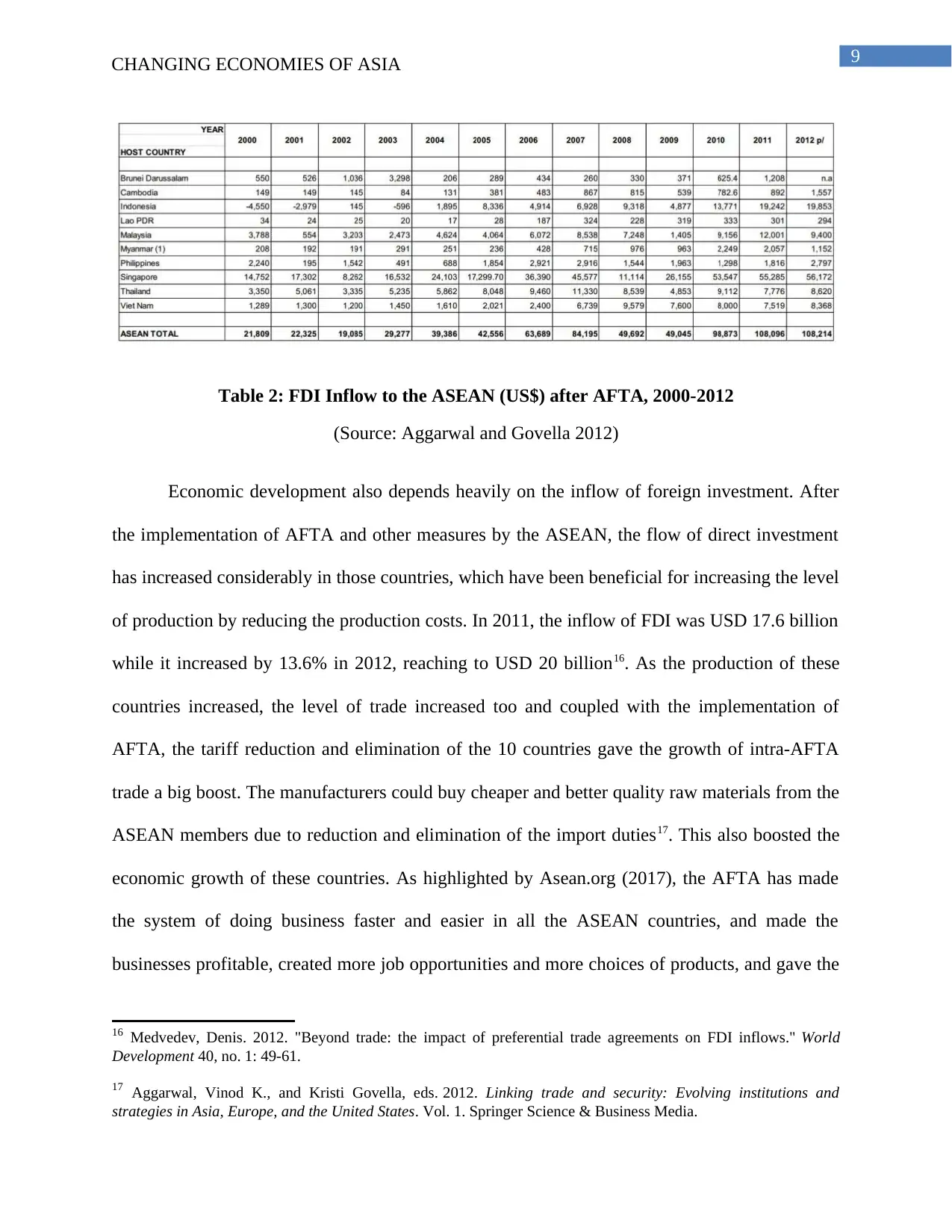
9CHANGING ECONOMIES OF ASIA
Table 2: FDI Inflow to the ASEAN (US$) after AFTA, 2000-2012
(Source: Aggarwal and Govella 2012)
Economic development also depends heavily on the inflow of foreign investment. After
the implementation of AFTA and other measures by the ASEAN, the flow of direct investment
has increased considerably in those countries, which have been beneficial for increasing the level
of production by reducing the production costs. In 2011, the inflow of FDI was USD 17.6 billion
while it increased by 13.6% in 2012, reaching to USD 20 billion16. As the production of these
countries increased, the level of trade increased too and coupled with the implementation of
AFTA, the tariff reduction and elimination of the 10 countries gave the growth of intra-AFTA
trade a big boost. The manufacturers could buy cheaper and better quality raw materials from the
ASEAN members due to reduction and elimination of the import duties17. This also boosted the
economic growth of these countries. As highlighted by Asean.org (2017), the AFTA has made
the system of doing business faster and easier in all the ASEAN countries, and made the
businesses profitable, created more job opportunities and more choices of products, and gave the
16 Medvedev, Denis. 2012. "Beyond trade: the impact of preferential trade agreements on FDI inflows." World
Development 40, no. 1: 49-61.
17 Aggarwal, Vinod K., and Kristi Govella, eds. 2012. Linking trade and security: Evolving institutions and
strategies in Asia, Europe, and the United States. Vol. 1. Springer Science & Business Media.
Table 2: FDI Inflow to the ASEAN (US$) after AFTA, 2000-2012
(Source: Aggarwal and Govella 2012)
Economic development also depends heavily on the inflow of foreign investment. After
the implementation of AFTA and other measures by the ASEAN, the flow of direct investment
has increased considerably in those countries, which have been beneficial for increasing the level
of production by reducing the production costs. In 2011, the inflow of FDI was USD 17.6 billion
while it increased by 13.6% in 2012, reaching to USD 20 billion16. As the production of these
countries increased, the level of trade increased too and coupled with the implementation of
AFTA, the tariff reduction and elimination of the 10 countries gave the growth of intra-AFTA
trade a big boost. The manufacturers could buy cheaper and better quality raw materials from the
ASEAN members due to reduction and elimination of the import duties17. This also boosted the
economic growth of these countries. As highlighted by Asean.org (2017), the AFTA has made
the system of doing business faster and easier in all the ASEAN countries, and made the
businesses profitable, created more job opportunities and more choices of products, and gave the
16 Medvedev, Denis. 2012. "Beyond trade: the impact of preferential trade agreements on FDI inflows." World
Development 40, no. 1: 49-61.
17 Aggarwal, Vinod K., and Kristi Govella, eds. 2012. Linking trade and security: Evolving institutions and
strategies in Asia, Europe, and the United States. Vol. 1. Springer Science & Business Media.
Secure Best Marks with AI Grader
Need help grading? Try our AI Grader for instant feedback on your assignments.
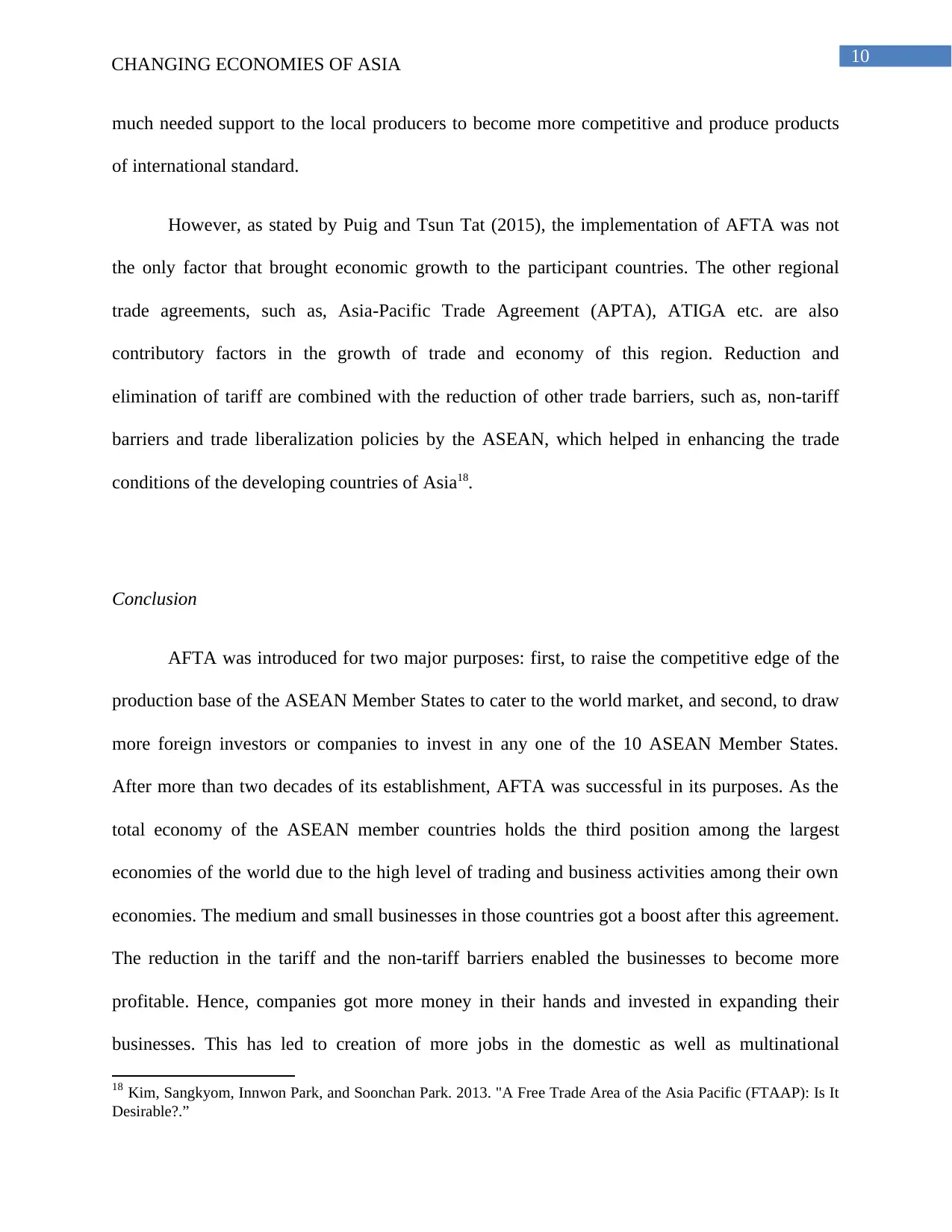
10CHANGING ECONOMIES OF ASIA
much needed support to the local producers to become more competitive and produce products
of international standard.
However, as stated by Puig and Tsun Tat (2015), the implementation of AFTA was not
the only factor that brought economic growth to the participant countries. The other regional
trade agreements, such as, Asia-Pacific Trade Agreement (APTA), ATIGA etc. are also
contributory factors in the growth of trade and economy of this region. Reduction and
elimination of tariff are combined with the reduction of other trade barriers, such as, non-tariff
barriers and trade liberalization policies by the ASEAN, which helped in enhancing the trade
conditions of the developing countries of Asia18.
Conclusion
AFTA was introduced for two major purposes: first, to raise the competitive edge of the
production base of the ASEAN Member States to cater to the world market, and second, to draw
more foreign investors or companies to invest in any one of the 10 ASEAN Member States.
After more than two decades of its establishment, AFTA was successful in its purposes. As the
total economy of the ASEAN member countries holds the third position among the largest
economies of the world due to the high level of trading and business activities among their own
economies. The medium and small businesses in those countries got a boost after this agreement.
The reduction in the tariff and the non-tariff barriers enabled the businesses to become more
profitable. Hence, companies got more money in their hands and invested in expanding their
businesses. This has led to creation of more jobs in the domestic as well as multinational
18 Kim, Sangkyom, Innwon Park, and Soonchan Park. 2013. "A Free Trade Area of the Asia Pacific (FTAAP): Is It
Desirable?.”
much needed support to the local producers to become more competitive and produce products
of international standard.
However, as stated by Puig and Tsun Tat (2015), the implementation of AFTA was not
the only factor that brought economic growth to the participant countries. The other regional
trade agreements, such as, Asia-Pacific Trade Agreement (APTA), ATIGA etc. are also
contributory factors in the growth of trade and economy of this region. Reduction and
elimination of tariff are combined with the reduction of other trade barriers, such as, non-tariff
barriers and trade liberalization policies by the ASEAN, which helped in enhancing the trade
conditions of the developing countries of Asia18.
Conclusion
AFTA was introduced for two major purposes: first, to raise the competitive edge of the
production base of the ASEAN Member States to cater to the world market, and second, to draw
more foreign investors or companies to invest in any one of the 10 ASEAN Member States.
After more than two decades of its establishment, AFTA was successful in its purposes. As the
total economy of the ASEAN member countries holds the third position among the largest
economies of the world due to the high level of trading and business activities among their own
economies. The medium and small businesses in those countries got a boost after this agreement.
The reduction in the tariff and the non-tariff barriers enabled the businesses to become more
profitable. Hence, companies got more money in their hands and invested in expanding their
businesses. This has led to creation of more jobs in the domestic as well as multinational
18 Kim, Sangkyom, Innwon Park, and Soonchan Park. 2013. "A Free Trade Area of the Asia Pacific (FTAAP): Is It
Desirable?.”
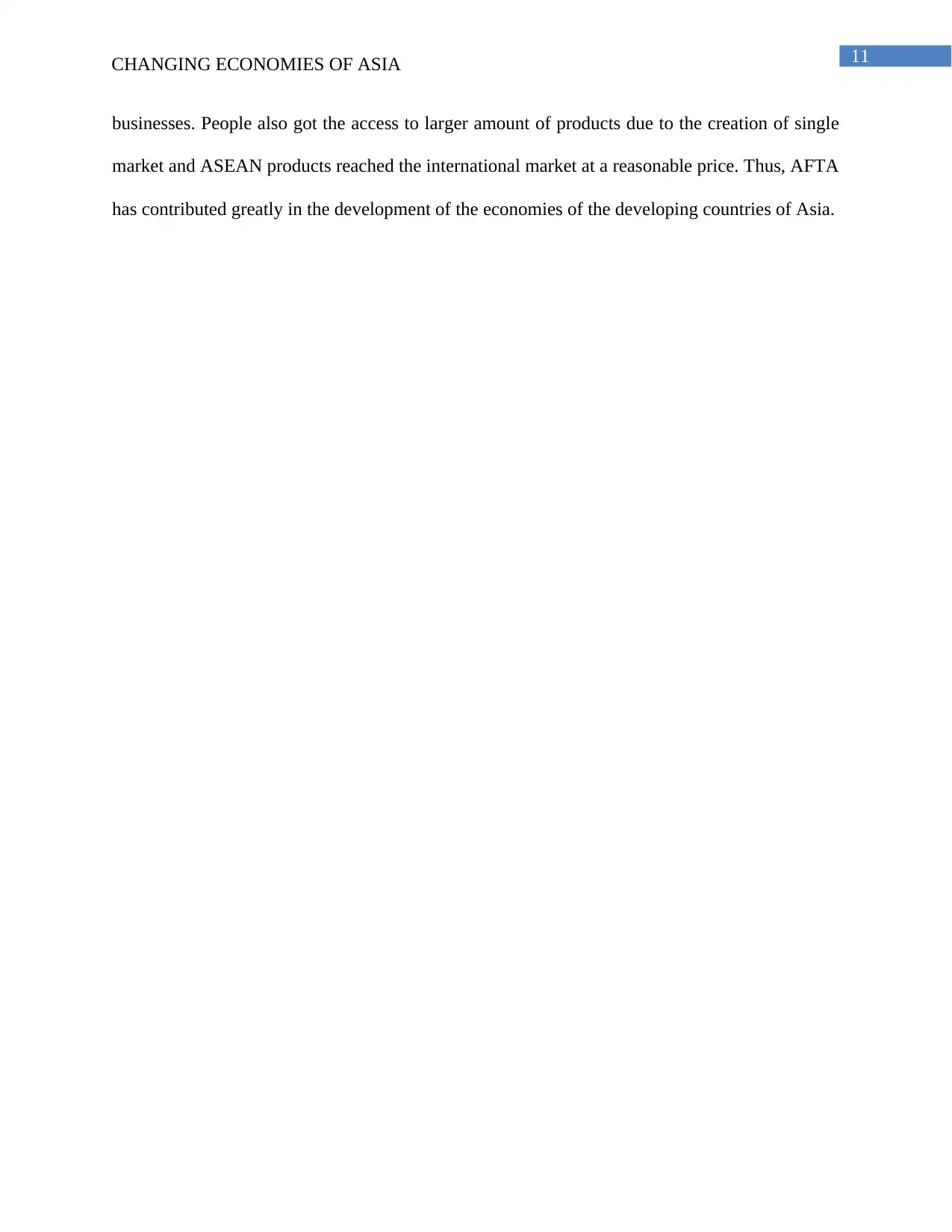
11CHANGING ECONOMIES OF ASIA
businesses. People also got the access to larger amount of products due to the creation of single
market and ASEAN products reached the international market at a reasonable price. Thus, AFTA
has contributed greatly in the development of the economies of the developing countries of Asia.
businesses. People also got the access to larger amount of products due to the creation of single
market and ASEAN products reached the international market at a reasonable price. Thus, AFTA
has contributed greatly in the development of the economies of the developing countries of Asia.
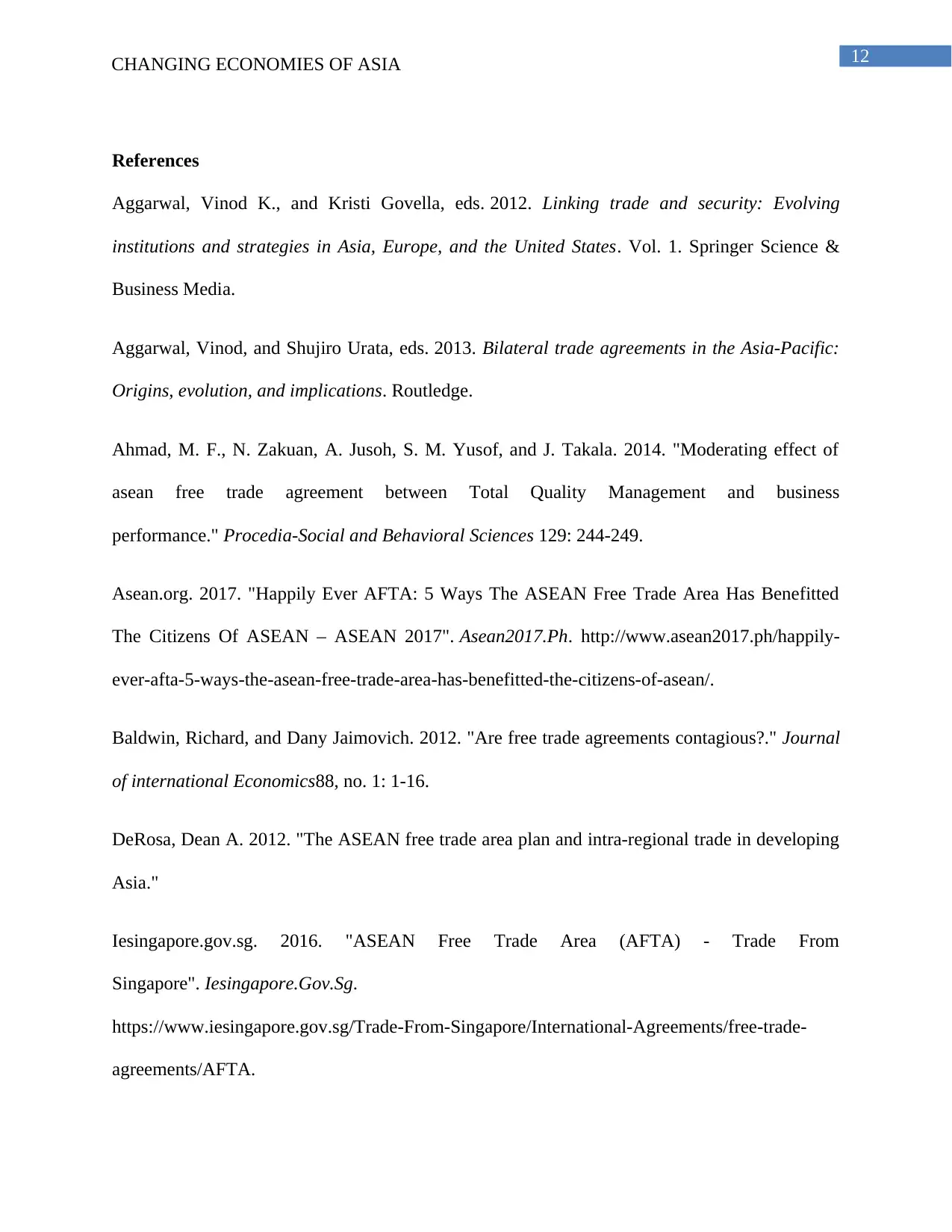
12CHANGING ECONOMIES OF ASIA
References
Aggarwal, Vinod K., and Kristi Govella, eds. 2012. Linking trade and security: Evolving
institutions and strategies in Asia, Europe, and the United States. Vol. 1. Springer Science &
Business Media.
Aggarwal, Vinod, and Shujiro Urata, eds. 2013. Bilateral trade agreements in the Asia-Pacific:
Origins, evolution, and implications. Routledge.
Ahmad, M. F., N. Zakuan, A. Jusoh, S. M. Yusof, and J. Takala. 2014. "Moderating effect of
asean free trade agreement between Total Quality Management and business
performance." Procedia-Social and Behavioral Sciences 129: 244-249.
Asean.org. 2017. "Happily Ever AFTA: 5 Ways The ASEAN Free Trade Area Has Benefitted
The Citizens Of ASEAN – ASEAN 2017". Asean2017.Ph. http://www.asean2017.ph/happily-
ever-afta-5-ways-the-asean-free-trade-area-has-benefitted-the-citizens-of-asean/.
Baldwin, Richard, and Dany Jaimovich. 2012. "Are free trade agreements contagious?." Journal
of international Economics88, no. 1: 1-16.
DeRosa, Dean A. 2012. "The ASEAN free trade area plan and intra-regional trade in developing
Asia."
Iesingapore.gov.sg. 2016. "ASEAN Free Trade Area (AFTA) - Trade From
Singapore". Iesingapore.Gov.Sg.
https://www.iesingapore.gov.sg/Trade-From-Singapore/International-Agreements/free-trade-
agreements/AFTA.
References
Aggarwal, Vinod K., and Kristi Govella, eds. 2012. Linking trade and security: Evolving
institutions and strategies in Asia, Europe, and the United States. Vol. 1. Springer Science &
Business Media.
Aggarwal, Vinod, and Shujiro Urata, eds. 2013. Bilateral trade agreements in the Asia-Pacific:
Origins, evolution, and implications. Routledge.
Ahmad, M. F., N. Zakuan, A. Jusoh, S. M. Yusof, and J. Takala. 2014. "Moderating effect of
asean free trade agreement between Total Quality Management and business
performance." Procedia-Social and Behavioral Sciences 129: 244-249.
Asean.org. 2017. "Happily Ever AFTA: 5 Ways The ASEAN Free Trade Area Has Benefitted
The Citizens Of ASEAN – ASEAN 2017". Asean2017.Ph. http://www.asean2017.ph/happily-
ever-afta-5-ways-the-asean-free-trade-area-has-benefitted-the-citizens-of-asean/.
Baldwin, Richard, and Dany Jaimovich. 2012. "Are free trade agreements contagious?." Journal
of international Economics88, no. 1: 1-16.
DeRosa, Dean A. 2012. "The ASEAN free trade area plan and intra-regional trade in developing
Asia."
Iesingapore.gov.sg. 2016. "ASEAN Free Trade Area (AFTA) - Trade From
Singapore". Iesingapore.Gov.Sg.
https://www.iesingapore.gov.sg/Trade-From-Singapore/International-Agreements/free-trade-
agreements/AFTA.
Paraphrase This Document
Need a fresh take? Get an instant paraphrase of this document with our AI Paraphraser
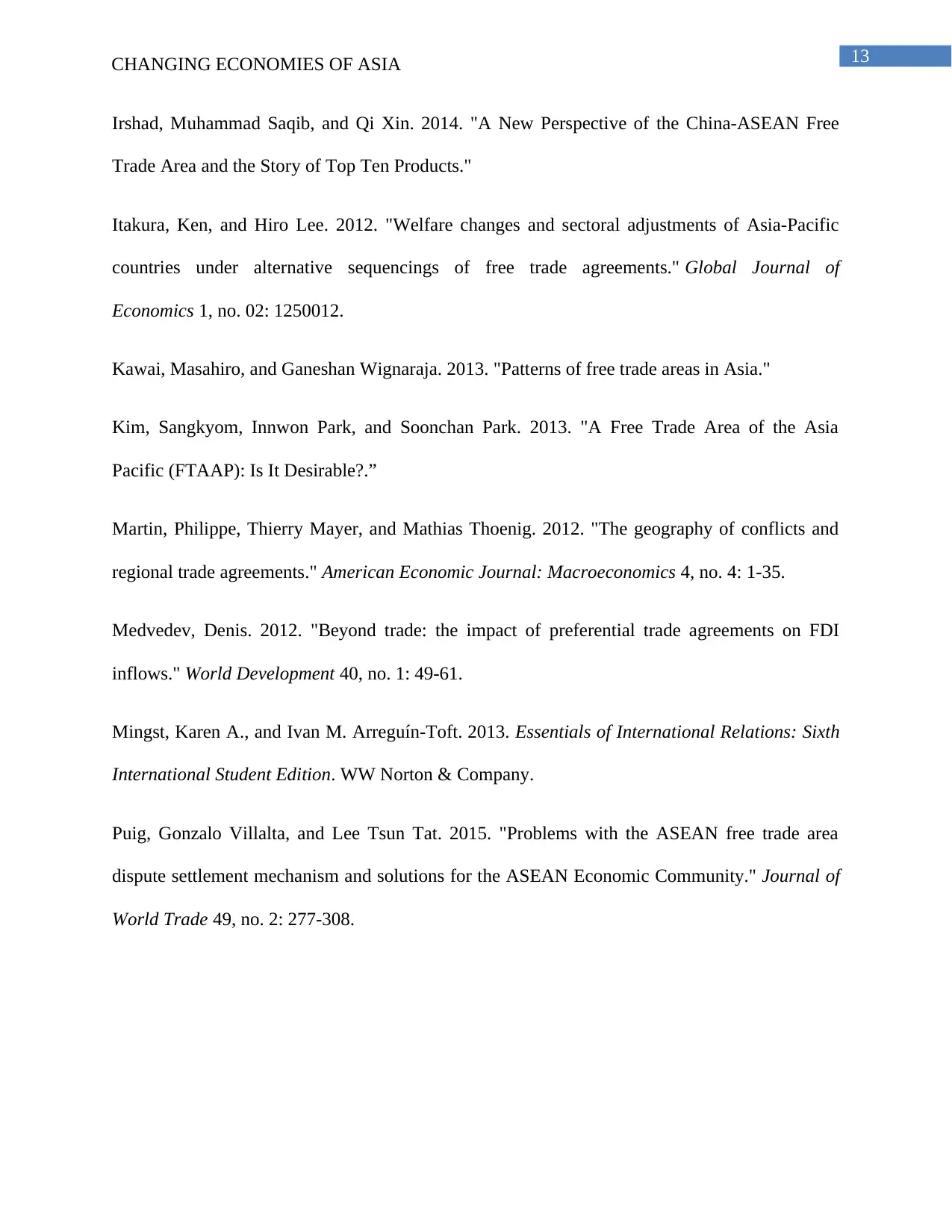
13CHANGING ECONOMIES OF ASIA
Irshad, Muhammad Saqib, and Qi Xin. 2014. "A New Perspective of the China-ASEAN Free
Trade Area and the Story of Top Ten Products."
Itakura, Ken, and Hiro Lee. 2012. "Welfare changes and sectoral adjustments of Asia-Pacific
countries under alternative sequencings of free trade agreements." Global Journal of
Economics 1, no. 02: 1250012.
Kawai, Masahiro, and Ganeshan Wignaraja. 2013. "Patterns of free trade areas in Asia."
Kim, Sangkyom, Innwon Park, and Soonchan Park. 2013. "A Free Trade Area of the Asia
Pacific (FTAAP): Is It Desirable?.”
Martin, Philippe, Thierry Mayer, and Mathias Thoenig. 2012. "The geography of conflicts and
regional trade agreements." American Economic Journal: Macroeconomics 4, no. 4: 1-35.
Medvedev, Denis. 2012. "Beyond trade: the impact of preferential trade agreements on FDI
inflows." World Development 40, no. 1: 49-61.
Mingst, Karen A., and Ivan M. Arreguín-Toft. 2013. Essentials of International Relations: Sixth
International Student Edition. WW Norton & Company.
Puig, Gonzalo Villalta, and Lee Tsun Tat. 2015. "Problems with the ASEAN free trade area
dispute settlement mechanism and solutions for the ASEAN Economic Community." Journal of
World Trade 49, no. 2: 277-308.
Irshad, Muhammad Saqib, and Qi Xin. 2014. "A New Perspective of the China-ASEAN Free
Trade Area and the Story of Top Ten Products."
Itakura, Ken, and Hiro Lee. 2012. "Welfare changes and sectoral adjustments of Asia-Pacific
countries under alternative sequencings of free trade agreements." Global Journal of
Economics 1, no. 02: 1250012.
Kawai, Masahiro, and Ganeshan Wignaraja. 2013. "Patterns of free trade areas in Asia."
Kim, Sangkyom, Innwon Park, and Soonchan Park. 2013. "A Free Trade Area of the Asia
Pacific (FTAAP): Is It Desirable?.”
Martin, Philippe, Thierry Mayer, and Mathias Thoenig. 2012. "The geography of conflicts and
regional trade agreements." American Economic Journal: Macroeconomics 4, no. 4: 1-35.
Medvedev, Denis. 2012. "Beyond trade: the impact of preferential trade agreements on FDI
inflows." World Development 40, no. 1: 49-61.
Mingst, Karen A., and Ivan M. Arreguín-Toft. 2013. Essentials of International Relations: Sixth
International Student Edition. WW Norton & Company.
Puig, Gonzalo Villalta, and Lee Tsun Tat. 2015. "Problems with the ASEAN free trade area
dispute settlement mechanism and solutions for the ASEAN Economic Community." Journal of
World Trade 49, no. 2: 277-308.
1 out of 14
Related Documents
Your All-in-One AI-Powered Toolkit for Academic Success.
+13062052269
info@desklib.com
Available 24*7 on WhatsApp / Email
![[object Object]](/_next/static/media/star-bottom.7253800d.svg)
Unlock your academic potential
© 2024 | Zucol Services PVT LTD | All rights reserved.





